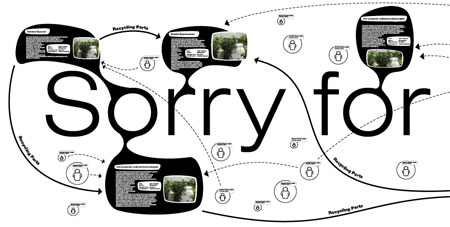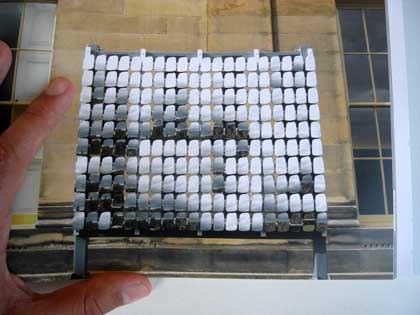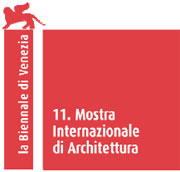Sorry for taking your mirrors - Venice Biennale of Architecture, curated exhibition

Exhibition about our work, methodologies, collaborations, and some actual experiments.
(under construction from Venice, 04 09 08)
The exhibition called “Sorry for Taking Your Mirrors” talks about new ways of creating spaces which are ‘high-tech’ and ‘low-tech’ at the same time: they are interactive, responsive, can physically change to accommodate various functions over time, but are built form reused everyday objects, which are readily available around the world. We are interested in architectural research into technological spaces that are low cost, enabling and welcoming.
Explore the poster above, wait the the graphics to load please
Our methodology – presented on this poster – is based a network or peer collaborators from various disciplines, and these projects become architectural research in the reading of the architect from the team, while they become other cultural products in other participants readings.
Keywords – collaborations, hacking, reusing, sustainability, soft spaces, open cultures, peer production, interactive architecture, responsive
Creating cultural qualities through the making of open interactive architecture systems
Peer Property’s Tangible Beauty
By allowing a diverse community to participate in the making of interactive architecture systems, the cultural qualities of such a system go beyond the usual ‘high tech’ and ‘smart home’ qualities, and create something genuine which at the same time does not belong to any single author’s or artist’s identity but to an undefined group of ‘participants’.
Together with Anita Pozna and Peter Hudini when we started our first projects in around 2002. We have been working as most other young offices, a team of former classmates forming a studio, working as consultants and investing time and webdesign-earned money to develop own content, experiments. Over the years we realized that working with professionals from other disciplines has a great advantage, projects are formed in collaboration, and we constantly learn from new people. This resulted that all projects I create is produced in collaboration with others.
Aleph Reorganizing Vision from Adam Somlai-Fischer on Vimeo.
This model is referred to in social science as Peer production, where individuals form horizontal networks per project basis. Today we consciously choose to work this way. Even thought we get many request, we refuse to grow and employ people, rather continue to look for interesting professionals to create joint projects with. As peer production creates peer property, cultural content that is created in collaboration, we extensively use a licensing that allows further remixing and sharing: Creative Commons. While copyrighting prohibits reuses of cultural products, sharing it via a CC license allows derivative works, remixes, etc.

A good example of this started with a manual-booklet that Usman Haque and me wrote in 2004, called Lowtech Sensors and Actuators (http://lowtech.propositions.org.uk/) which was published with a CC license and was made freely available on the net. In 2006 for the Venice Architecture Biennale we used this booklet to build some of the large scale installations of Reorient (www.reorient.hu) which itself was licensed the same way. In 2007 spring, allowing by this licensing, Usman and me reused many actual parts from the Reorient installation to build Reconfigurable House (http://house.propositions.org.uk/) for NTT ICC’s anniversary exhibition in Tokyo. In this example ideas and products got reused by various people over the years, and derivative works were created.
Lowtech Sensors and Actuators from Adam Somlai-Fischer on Vimeo.
(… extract from essay for the 2006 Reorient exhibition…)
The built environment, our spaces are vehicles and transformers of our identity, charged with personal and emotional decisions; they give home to our communities and our emotions. With thousands of aesthetic decisions, we slowly shape our cities, which thus become the treasury of our memories. Although this is an old story, the process is becoming increasingly fragmented, and will be transformed into a network. This is partly due to the development of technological media: the spread of customisable spaces has considerably altered our notions of personal or communal space. Is it not a strange feeling when a friend sneaks a peek into our “My Documents” folder, and do we not make stereotypical assessments of people on the basis of how the icons are arranged on their Desktops? But let us go even further. What has changed is not only the idea of space, but thanks to the adaptability of media spaces, also how space is designed. We receive the graphic user interface of an operating system as an end product, but then we customise it. I know that the concept of an architecture that is shaped by its users is half a century old, and I am aware of the many failed experiments.
Reorient Migrating Architecture Exhibition from Adam Somlai-Fischer on Vimeo.
Architecture transforms in a social process, relies on a host of consensuses, and it is not a single-author medium, if architects often insist on the contrary. This is why it is worth keeping an eye on those changes that occur in media with a lower inertia (ones that take less energy to change), like writing. With the appearance of Wikipedia and the blogosphere, community decisions and authority based on personal, rather than institutional trust are constantly growing in importance. Now that we are already entrusting our knowledge to joint decisions, it may be fair to assume that we will be less and less inclined to accept the authority of the designing professions.
The massive presence of electronic devices, made chiefly in the Far East, and particularly in China, may pose a very interesting alternative: the vision of ubiquitous computing did not grow out of the elite research laboratories of developed countries, but of cheap lighters playing silly songs. The millions of infrared links, IC’s, sensors, communicating objects will start to build this global network of technological reality. And then the ubiquitous will include the spaces of pantries, garages, handbags, living and bedrooms, the world of the technological media will open for the domestic, showing the way to a new kind of literacy. The migration of these objects, and the associated cultural narratives will create considerable changes in our culture of spaces and objects.
Adam Somlai-Fischer




